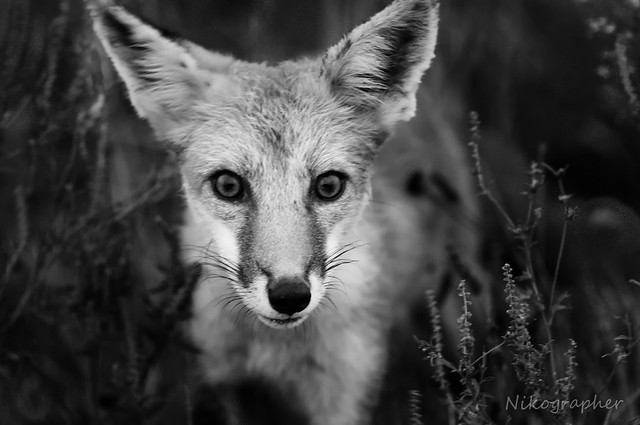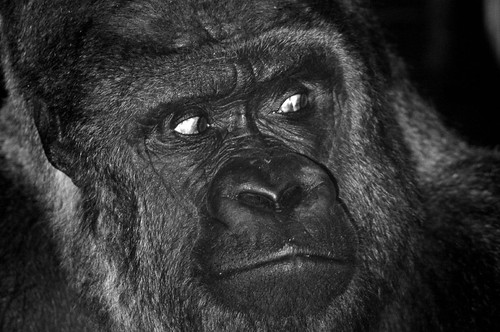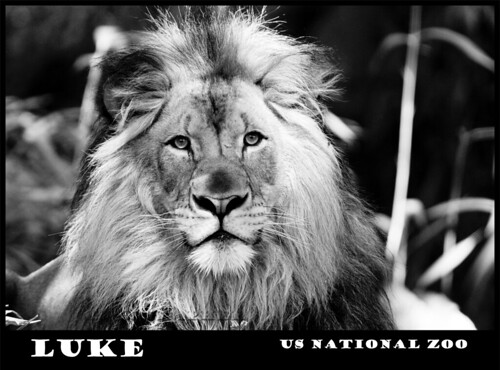From http://natureandwildlifephotography.blogspot.com/
I've meant to do more posts like this one. A quick take on the edit techniques used to process an image. Doing this for a straightforward image with little edits doesn't offer much. But for many images that I make there's a decent distance between what the camera captured, and how I've interpreted it, edited it, and then produced the final image.
Here's a composite with the final image on top. The bottom two images are from the raw file and are the basic images, reset to defaults in Lightroom and then color (default) and grayscale.
One of the main problems with the source image was it wasn't that sharp. It was the sharpest of the bunch from the encounter, but at 1/30th of a second at f/4, and a mix of handheld and resting on my car window/beanbag - it was hard to get a sharp shot.
color/default-raw
The sharpest part is his nose, and the DoF falls off pretty quickly. As a straight color image his eyes and attention are gripping but the image itself isn't refined enough in my opinion. The above is overly flat due to no processing, but shows signs of animal behavior and intent and that'x what drew me to the photo/moment.
Default/Grayscale
Switching to grayscale removes color and distraction, and elements that might make the mind wander. Color is a strong element on its own but for this image I really wanted to narrow the scope of it to just the fox. Converting to black and white, even though I have black and white on the brain lately, was probably a very justified move.
OK - so that's the setup. That's what I had to work with. I had seen the fox and due to the low light was shooting at pretty slow shutter speeds and wide open. My personal preference is to shoot wide open at ISO 400 and SLOW shutter speeds and let the cards fall where they may on sharpness. I don't always stick to this rule, but I try to avoid shooting at any ISO above 400. There's something about my D300 and D300s that ISO500 or beyond, just make me concerned regarding noise.
Anyway... I've been reading a book. I got it probably a year ago and just picked it up again. The book is Vincent Versace's "Welcome to Oz". In it he describes using Photoshop to turn a source image in to an artistic vision, an interpretation, something where the source file is just the starting point.
I highly recommend everyone listen to this podcast with Vinny (as I hear he's called).
Some of the concepts he talks about are how the eye moves through an image - light to dark, high contrast to low contrast, etc, etc..... Things that make sense but not what you might be concerned with when processing an image where you are really trying to (for me anyway) showcase a subject (often an animal) and show to others what you see.
So - here's the final black and white edit. This was done in Lightroom, and I used the adjustment brush a few times with different levels of lightening and darkening. 
A few key edits I did were to darken the image and edges, and brighten the eyes and his nose. I also darkened the original bright spot on tht http://natureandwildlifephotography.blogspot.com/e right. Having done that edit, I removed some noise in PS with D-fine, and added my logo.
It's fine to want to get it all right in camera and I shoot for that too. Heck I shot jpg for like 3 years! Now that I shoot RAW and manual mode I strive for getting the source file as good as possible. However there's often much more to an image than that.
Let me know what you think. I'm not looking to stir up the purist's who'd capture it in camera and do NO edits ever... What do folks think about editing images to enhance and convey, and make an image become an artist photo?
-Jon![]()
Thursday, September 9, 2010
A Photo Edit - Black and White Red Fox
Friday, September 3, 2010
Black and White Photography
From - http://natureandwildlifephotography.blogspot.com/
Black and white photography is nice right, but color is so much better! Well, hmmm.
These days we all shoot color. There's no "film" in the digital world anymore, and they don't make "black and white cameras" - so that's just how it is. Color.
But really, black and white can be even stronger than color. In a way it is like the power of still over motion pictures. Movies convey more info, but a still image is less and therefore more refined, the data is more concentrated on the message or specific moment, or mood captured.
I am new to thinking in black and white. I did shoot black and white film in school and did the development myself, but that was forever ago.
A handful of times I've found B&W images or digital conversions to be the way to go. Often it is for Gorillas or Giant Pandas at the zoo. 



A week ago I was listening to a podcast or something and I decided to make a change to my camera, to how I shoot and maybe how I see.
On my D300s I enabled monochromatic mode, while set to RAW+JPG. This has a couple of nice benefits. Shooting RAW still allows for everything I've been used to - full color images, RAW processing, etc. But it also makes the back of the camera images all visible in black and white. And it saves a copy of the black and white iamge as a JPG.
I think I'm going to leave it like this for a while. Maybe even try to turn it in to a project. The going vertical project from a number of months ago was fun and helped kick me in a different direction, and helped me to think and see just a little differently. I shoot both ways, but restricted my posting for about 50 shots in a row to vertical only.
The effects of trying to see and shoot in black and white might be even more beneficial. Good color can make an ok image better, but if it were better to begin with the color might set it over the top. Black and white. I'm hoping it raises my composition skills, and gives me a better eye.
We'll see. Stay tuned.
-Jon![]()
Black and White Photography







